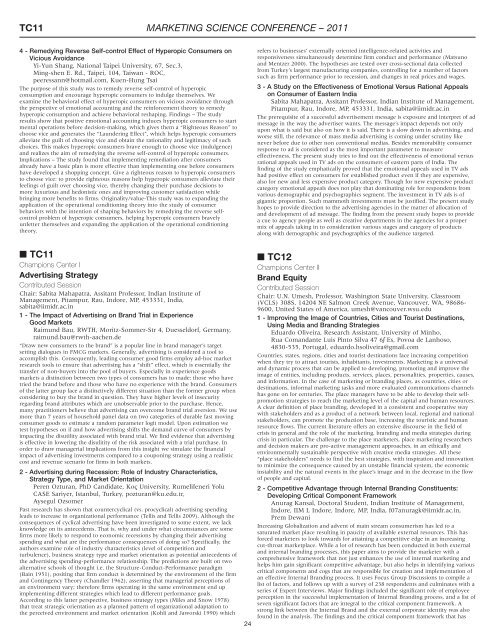Conference Sessions - Jesse H. Jones Graduate School of ...
Conference Sessions - Jesse H. Jones Graduate School of ...
Conference Sessions - Jesse H. Jones Graduate School of ...
Create successful ePaper yourself
Turn your PDF publications into a flip-book with our unique Google optimized e-Paper software.
TC11 MARKETING SCIENCE CONFERENCE – 2011<br />
4 - Remedying Reverse Self-control Effect <strong>of</strong> Hyperopic Consumers on<br />
Vicious Avoidance<br />
Yi-Yun Shang, National Taipei University, 67, Sec.3,<br />
Ming-shen E. Rd., Taipei, 104, Taiwan - ROC,<br />
peeressann@hotmail.com, Kuen-Hung Tsai<br />
The purpose <strong>of</strong> this study was to remedy reverse self-control <strong>of</strong> hyperopic<br />
consumption and encourage hyperopic consumers to indulge themselves. We<br />
examine the behavioral effect <strong>of</strong> hyperopic consumers on vicious avoidance through<br />
the perspective <strong>of</strong> emotional accounting and the reinforcement theory to remedy<br />
hyperopic consumption and achieve behavioral reshaping. Findings – The study<br />
results show that positive emotional accounting induces hyperopic consumers to start<br />
mental operations before decision-making, which gives them a “Righteous Reason” to<br />
choose vice and generates the “Laundering Effect”, which helps hyperopic consumers<br />
alleviate the guilt <strong>of</strong> choosing vice and obtain the rationality and legitimacy <strong>of</strong> such<br />
choices. This makes hyperopic consumers brave enough to choose vice (indulgence)<br />
and realizes the aim <strong>of</strong> remedying the reverse self-control <strong>of</strong> hyperopic consumers.<br />
Implications – The study found that implementing remediation after consumers<br />
already have a basic plan is more effective than implementing one before consumers<br />
have developed a shopping concept. Give a righteous reason to hyperopic consumers<br />
to choose vice: to provide righteous reasons help hyperopic consumers alleviate their<br />
feelings <strong>of</strong> guilt over choosing vice, thereby changing their purchase decisions to<br />
more luxurious and hedonistic ones and improving customer satisfaction while<br />
bringing more benefits to firms. Originality/value-This study was to expanding the<br />
application <strong>of</strong> the operational conditioning theory into the study <strong>of</strong> consumer<br />
behaviors with the intention <strong>of</strong> shaping behaviors by remedying the reverse selfcontrol<br />
problem <strong>of</strong> hyperopic consumers, helping hyperopic consumers bravely<br />
unfetter themselves and expanding the application <strong>of</strong> the operational conditioning<br />
theory.<br />
■ TC11<br />
Champions Center I<br />
Advertising Strategy<br />
Contributed Session<br />
Chair: Sabita Mahapatra, Assitant Pr<strong>of</strong>essor, Indian Institute <strong>of</strong><br />
Management, Pitampur, Rau, Indore, MP, 453331, India,<br />
sabita@iimidr.ac.in<br />
1 - The Impact <strong>of</strong> Advertising on Brand Trial in Experience<br />
Good Markets<br />
Raimund Bau, RWTH, Moritz-Sommer-Str 4, Duesseldorf, Germany,<br />
raimund.bau@rwth-aachen.de<br />
“Draw new consumers to the brand” is a popular line in brand manager’s target<br />
setting dialogues in FMCG markets. Generally, advertising is considered a tool to<br />
accomplish this. Consequently, leading consumer good firms employ ad-hoc market<br />
research tools to ensure that advertising has a “shift” effect, which is essentially the<br />
transfer <strong>of</strong> non-buyers into the pool <strong>of</strong> buyers. Especially in experience goods<br />
markets a distinction between two types <strong>of</strong> consumers has to made: those who have<br />
tried the brand before and those who have no experience with the brand. Consumers<br />
<strong>of</strong> the latter group face a distinctively different situation than the former group when<br />
considering to buy the brand in question. They have higher levels <strong>of</strong> insecurity<br />
regarding brand attributes which are unobservable prior to the purchase. Hence,<br />
many practitioners believe that advertising can overcome brand trial aversion. We use<br />
more than 7 years <strong>of</strong> household panel data on two categories <strong>of</strong> durable fast moving<br />
consumer goods to estimate a random parameter logit model. Upon estimation we<br />
test hypotheses on if and how advertising shifts the demand curve <strong>of</strong> consumers by<br />
impacting the disutility associated with brand trial. We find evidence that advertising<br />
is effective in lowering the disulitity <strong>of</strong> the risk associated with a trial purchase. In<br />
order to draw managerial implications from this insight we simulate the financial<br />
impact <strong>of</strong> advertising investments compared to a couponing strategy using a realistic<br />
cost and revenue scenario for firms in both markets.<br />
2 - Advertising during Recession: Role <strong>of</strong> Industry Characteristics,<br />
Strategy Type, and Market Orientation<br />
Peren Ozturan, PhD Candidate, Koç University, Rumelifeneri Yolu<br />
CASE Sariyer, Istanbul, Turkey, pozturan@ku.edu.tr,<br />
Aysegul Ozsomer<br />
Past research has shown that countercyclical (vs. procyclical) advertising spending<br />
leads to increase in organizational performance (Tellis and Tellis 2009). Although the<br />
consequences <strong>of</strong> cyclical advertising have been investigated to some extent, we lack<br />
knowledge on its antecedents. That is, why and under what circumstances are some<br />
firms more likely to respond to economic recessions by changing their advertising<br />
spending and what are the performance consequences <strong>of</strong> doing so? Specifically, the<br />
authors examine role <strong>of</strong> industry characteristics (level <strong>of</strong> competition and<br />
turbulence), business strategy type and market orientation as potential antecedents <strong>of</strong><br />
the advertising spending-performance relationship. The predictions are built on two<br />
alternative schools <strong>of</strong> thought i.e. the Structure-Conduct-Performance paradigm<br />
(Bain 1951), positing that firm conduct is determined by the environment <strong>of</strong> the firm<br />
and Contingency Theory (Chandler 1962), asserting that managerial perceptions <strong>of</strong><br />
an environment vary; therefore firms operating in the same environment end up<br />
implementing different strategies which lead to different performance goals.<br />
According to this latter perspective, business strategy types (Miles and Snow 1978)<br />
that treat strategic orientation as a planned pattern <strong>of</strong> organizational adaptation to<br />
the perceived environment and market orientation (Kohli and Jaworski 1990) which<br />
24<br />
refers to businesses’ externally oriented intelligence-related activities and<br />
responsiveness simultaneously determine firm conduct and performance (Matsuno<br />
and Mentzer 2000). The hypotheses are tested over cross-sectional data collected<br />
from Turkey’s largest manufacturing companies, controlling for a number <strong>of</strong> factors<br />
such as firm performance prior to recession, and changes in real prices and wages.<br />
3 - A Study on the Effectiveness <strong>of</strong> Emotional Versus Rational Appeals<br />
on Consumer <strong>of</strong> Eastern India<br />
Sabita Mahapatra, Assitant Pr<strong>of</strong>essor, Indian Institute <strong>of</strong> Management,<br />
Pitampur, Rau, Indore, MP, 453331, India, sabita@iimidr.ac.in<br />
The prerequisite <strong>of</strong> a successful advertisement message is exposure and interpret <strong>of</strong> ad<br />
message in the way the advertiser wants. The message’s impact depends not only<br />
upon what is said but also on how it is said. There is a slow down in advertising, and<br />
worse still, the relevance <strong>of</strong> mass media advertising is coming under scrutiny like<br />
never before due to other non conventional medias. Besides memorability consumer<br />
response to ad is considered as the most important parameter to measure<br />
effectiveness. The present study tries to find out the effectiveness <strong>of</strong> emotional versus<br />
rational appeals used in TV ads on the consumers <strong>of</strong> eastern parts <strong>of</strong> India. The<br />
finding <strong>of</strong> the study emphatically proved that the emotional appeals used in TV ads<br />
had positive effect on consumers for established product even if they are expensive,<br />
also for new and less expensive product category. Though for new expensive product<br />
category emotional appeals does not play that dominating role for respondents from<br />
various demographic and psychographics segment. The investment in TV ads is <strong>of</strong><br />
gigantic proportion. Such mammoth investments must be justified. The present study<br />
hopes to provide direction to the advertising agencies in the matter <strong>of</strong> allocation <strong>of</strong><br />
and development <strong>of</strong> ad message. The finding from the present study hopes to provide<br />
a cue to agency people as well as creative departments in the agencies for a proper<br />
mix <strong>of</strong> appeals taking in to consideration various stages and category <strong>of</strong> products<br />
along with demographic and psychographics <strong>of</strong> the audience targeted.<br />
■ TC12<br />
Champions Center II<br />
Brand Equity<br />
Contributed Session<br />
Chair: U.N. Umesh, Pr<strong>of</strong>essor, Washington State University, Classroom<br />
(VCLS) 308S, 14204 NE Salmon Creek Avenue, Vancouver, WA, 98686-<br />
9600, United States <strong>of</strong> America, umesh@vancouver.wsu.edu<br />
1 - Improving the Image <strong>of</strong> Countries, Cities and Tourist Destinations,<br />
Using Media and Branding Strategies<br />
Eduardo Oliveira, Research Assistant, University <strong>of</strong> Minho,<br />
Rua Comandante Luis Pinto Silva 47 6∫ Es, Povoa de Lanhoso,<br />
4830-535, Portugal, eduardo.hsoliveira@gmail.com<br />
Countries, states, regions, cities and tourist destinations face increasing competition<br />
when they try to attract tourists, inhabitants, investments. Marketing is a universal<br />
and dynamic process that can be applied to developing, promoting and improve the<br />
image <strong>of</strong> entities, including products, services, places, personalities, properties, causes,<br />
and information. In the case <strong>of</strong> marketing or branding places, as countries, cities or<br />
destinations, informal marketing tasks and more evaluated communications channels<br />
has gone on for centuries. The place managers have to be able to develop their selfpromotion<br />
strategies to reach the marketing level <strong>of</strong> the capital and human resources.<br />
A clear definition <strong>of</strong> place branding, developed in a consistent and cooperative way<br />
with stakeholders and as a product <strong>of</strong> a network between local, regional and national<br />
stakeholders, can promote the production base, increasing the touristic and human<br />
resource flows. The current literature <strong>of</strong>fers an extensive discourse in the field <strong>of</strong><br />
crisis in general and the role <strong>of</strong> the marketing, branding and media strategies during<br />
crisis in particular. The challenge to the place marketers, place marketing researchers<br />
and decision makers are pro-active management approaches, in an ethically and<br />
environmentally sustainable perspective with creative media strategies. All these<br />
“place stakeholders” needs to find the best strategies, with inspiration and innovation<br />
to minimize the consequence caused by an unstable financial system, the economic<br />
instability and the natural events in the place’s image and in the decrease in the flow<br />
<strong>of</strong> people and capital.<br />
2 - Competitive Advantage through Internal Branding Constituents:<br />
Developing Critical Component Framework<br />
Anurag Kansal, Doctoral Student, Indian Institute <strong>of</strong> Management,<br />
Indore, IIM I, Indore, Indore, MP, India, f07anuragk@iimidr.ac.in,<br />
Prem Dewani<br />
Increasing Globalization and advent <strong>of</strong> main stream consumerism has led to a<br />
saturated market place resulting in paucity <strong>of</strong> available external resources. This has<br />
forced marketers to look inwards for attaining a competitive edge in an increasing<br />
cut-throat marketplace. While a lot <strong>of</strong> research has been conducted in both external<br />
and internal branding processes, this paper aims to provide the marketer with a<br />
comprehensive framework that not just enhances the use <strong>of</strong> internal marketing and<br />
helps him gain significant competitive advantage, but also helps in identifying various<br />
critical components and cogs that are responsible for creation and implementation <strong>of</strong><br />
an effective Internal Branding process. It uses Focus Group Discussions to compile a<br />
list <strong>of</strong> factors, and follows up with a survey <strong>of</strong> 238 respondents and culminates with a<br />
series <strong>of</strong> Expert Interviews. Major findings included the significant role <strong>of</strong> employee<br />
perception in the successful implementation <strong>of</strong> Internal Branding process, and a list <strong>of</strong><br />
seven significant factors that are integral to the critical component framework. A<br />
strong link between the Internal Brand and the external corporate identity was also<br />
found in the analysis. The findings and the critical component framework that has

















